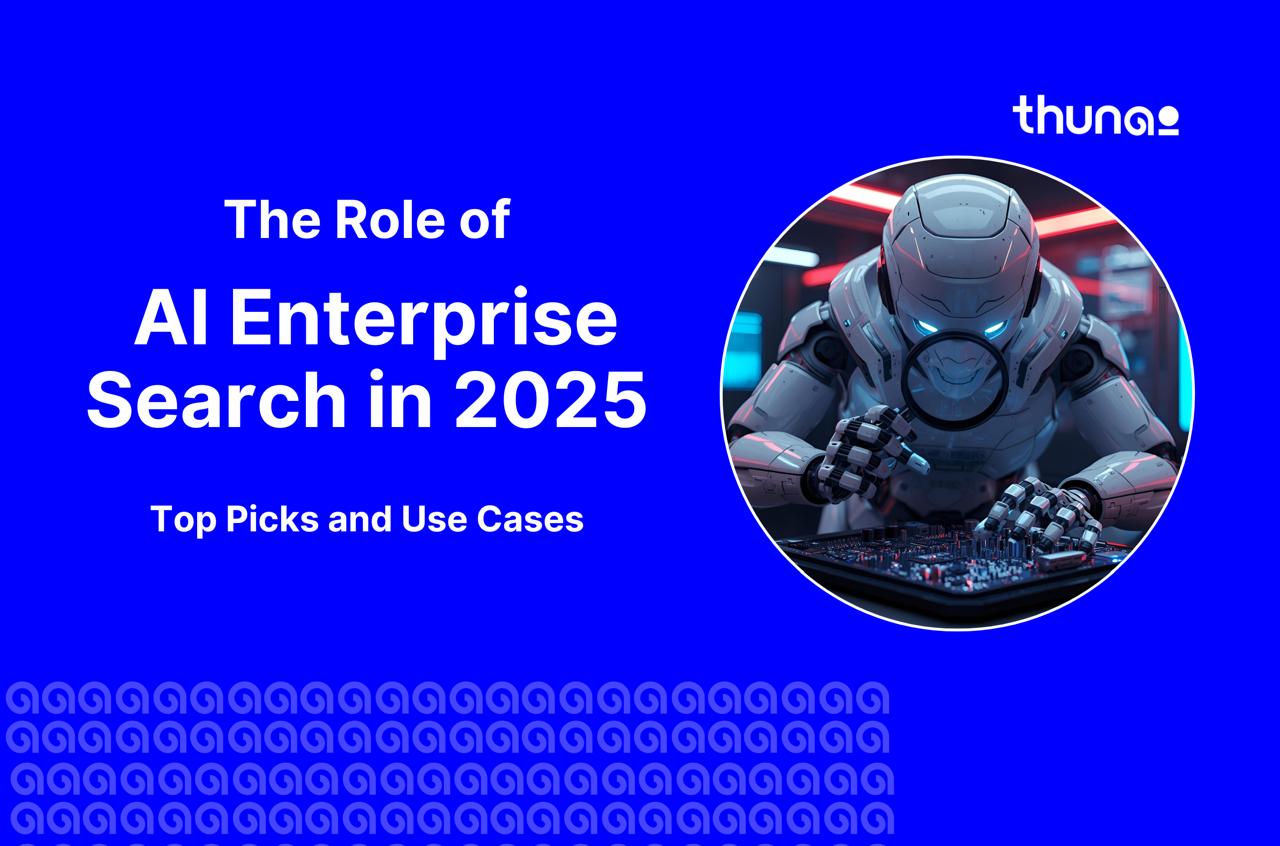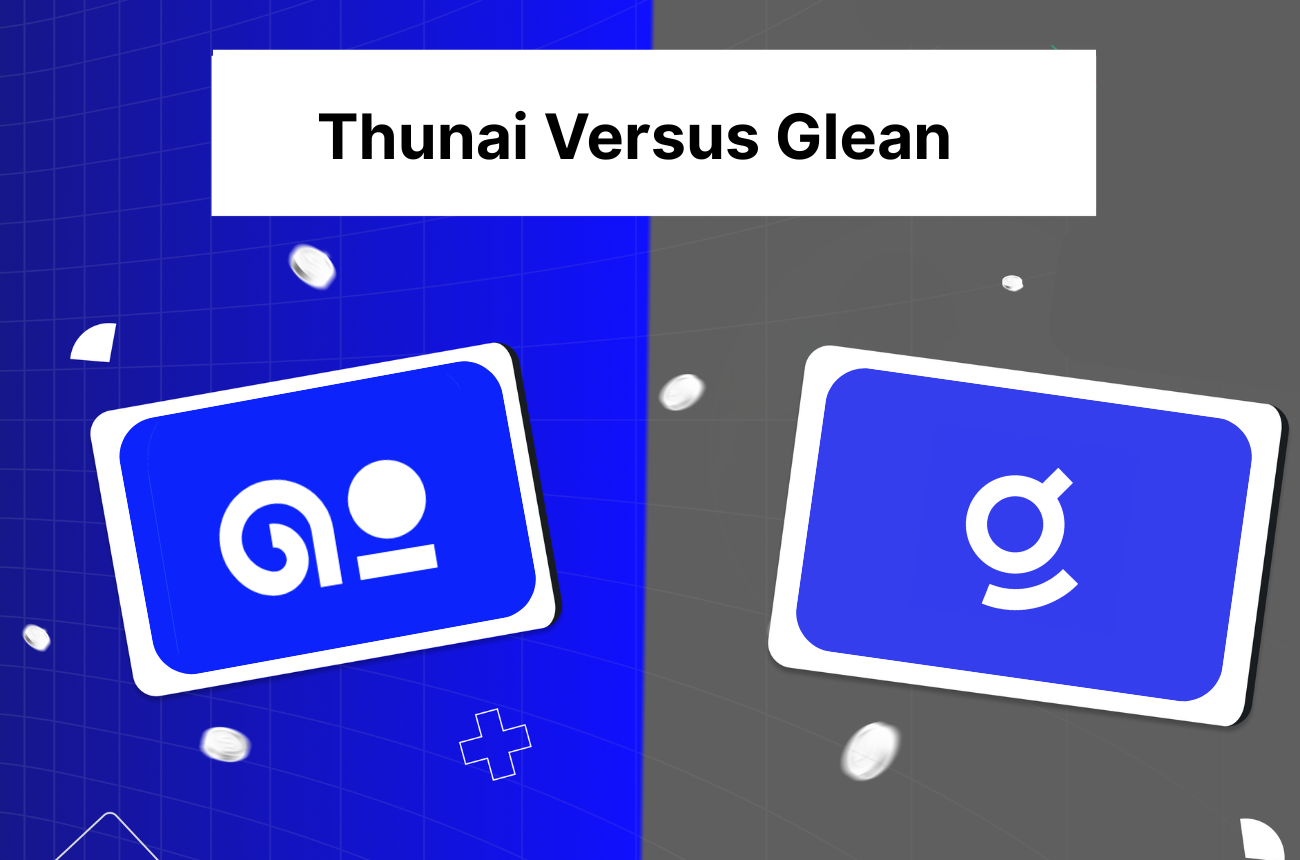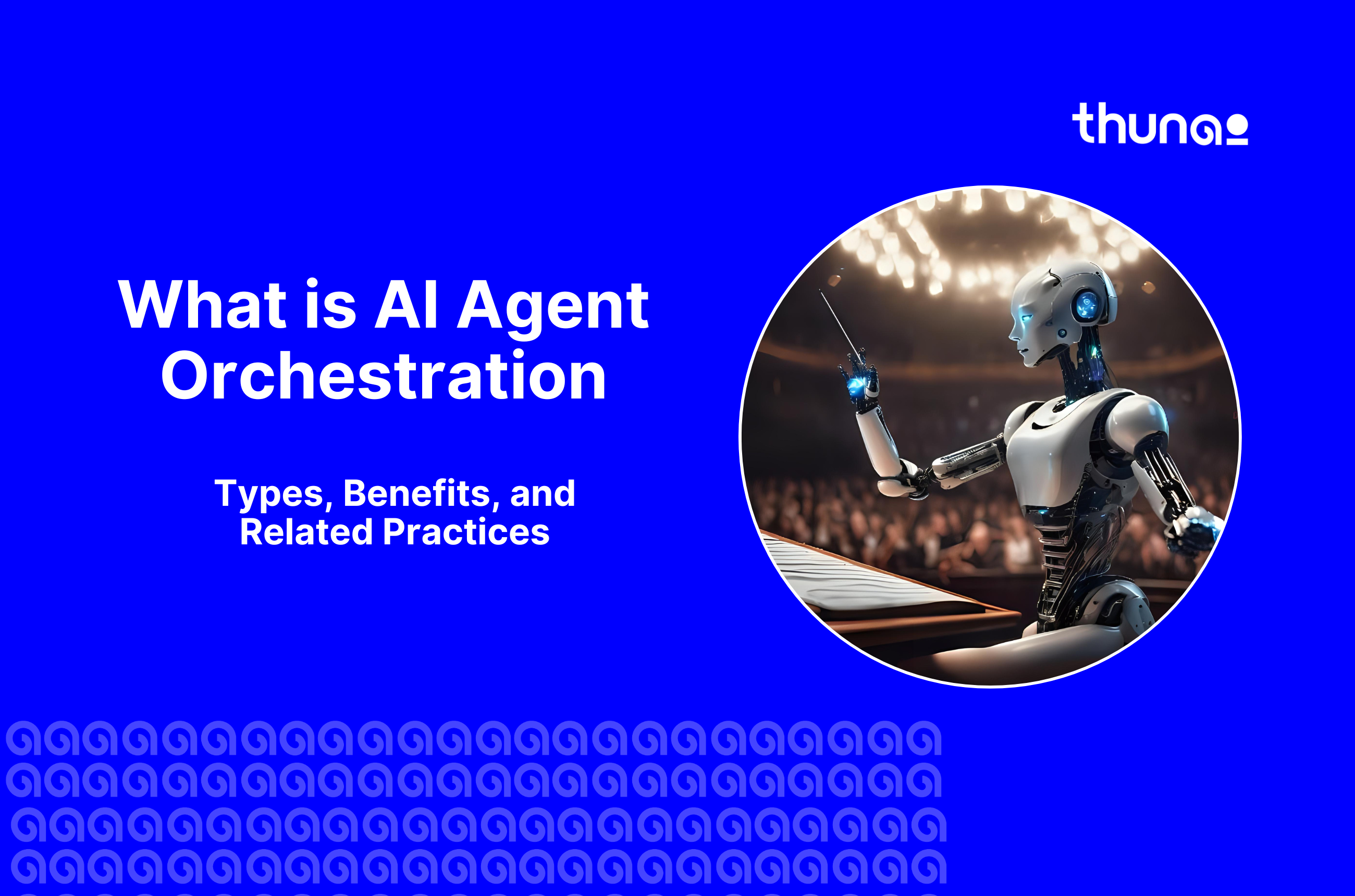The Role of AI Enterprise Search in 2025 - Top Picks and Use Cases



Thunai learns, listens, communicates, and automates workflows for your revenue generation team - Sales, Marketing and Customer Success.
TL;DR
Summary
- Employees waste an average of 3.2 hours per week searching for internal information, costing companies over a full month of lost productivity per employee every year.
- AI search solves this by providing instant answers, helping companies save over 15,000 employee hours per month.
- Modern AI uses Retrieval-Augmented Generation (RAG) to ensure accuracy by grounding answers in company data, preventing hallucinations.
- Gartner projects that over 80% of businesses will be using generative AI applications by 2026.
Is your company data spread out and disorganized?
Not being able to find internal knowledge is a MAJOR issue. But you’re not alone in it; this is a problem that’s a large drain on productivity that many companies face.
The worst part? Older search tools have not been able to solve it.
Luckily, AI enterprise search solves this problem, and here’s how…
Role of AI in Enterprise Search
By 2025, artificial intelligence will have greatly changed enterprise search. The purpose of the search is no longer just to find documents. The main goal now is to put together direct, dependable, and context-aware answers. This progress has changed search from a basic tool into an important intelligence system for future knowledge work.
The Failure of Older Systems
- The shortcomings of old enterprise search are in their design. These systems depend on exact keyword matching. This method cannot figure out what a user wants or understand the details of human language.
- For instance, an old tool looking for a PTO policy would not find documents named Vacation Days. The keywords do not match, even though the meaning is the same. This is not just a productivity problem.
- This is also a serious operational and financial risk. The development of the Boeing Dreamliner is a good example. The inability to pass on important information among teams led to large cost increases. This also brought about major project delays.
The AI-Based Solution
- Modern AI enterprise search gets around these issues. The system brings together Natural Language Processing (NLP), vector search, and Retrieval-Augmented Generation (RAG).
- The market for AI enterprise search responded with large investments. Gartner projects that by 2026, more than 80 percent of businesses will have put Generative AI applications to use. This is a huge increase from less than 5 percent in 2023.
- Putting money into AI enterprise search is a direct, high-return action to get back lost productivity.
How Enterprise Search Works
AI enterprise search works by combining several AI technologies. Unlike older tools, modern platforms and AI enterprise search work at a logic-based or reasoning level.
These top AI enterprise search tools have moved on from a simple database lookup method to a cognitive understanding method that works like human thought. The path from a user's question to a complete answer follows a detailed, five-step process.
- Crawling and Indexing: The system links up with a business's different data sources. These include structured databases and unstructured data in chat messages. This step makes a single list of all knowledge assets.
- Content and Metadata Analysis: The AI looks over the content of each item. The system figures out keywords, items like people or products, and even the feeling of the text. This step adds a layer of machine-readable context.
- AI-Based Question Interpretation: When a user types in a question, the system uses AI to understand the user's real goal. The system goes beyond matching the exact words.
- Natural Language Processing (NLP) Application: NLP lets the system sort out the complexities of human language. The system processes conversational questions and understands the relationships between words.
- Machine Learning Refinement: The system uses machine learning to learn from user actions, like which results people click on. This improves its ranking models over time. This makes the AI enterprise search more accurate and personalized.
Key Technological Drivers
- NLP and Semantic Understanding: NLP allows users to ask questions in a normal way. Semantic search is a deeper use of this. The search centers on the meaning behind a question. This lets the system find conceptually related results that may not have the exact search words.
- Vector Search: This technology changes text and other data into numerical vectors. These vectors hold on to semantic meaning. By measuring the mathematical distance between vectors, the AI enterprise search tool or system can find information based on how close concepts are, not just on word overlap.
- Machine Learning and Personalization: ML algorithms permit the platform to get smarter with use. By looking into user interactions, the AI enterprise search tool can adjust search results for a person's job and history. This makes sure the most relevant information shows up first.
How Generative AI Has Changed Enterprise Search
Adding in Generative AI, which uses Large Language Models (LLMs), is the biggest change to AI enterprise search. This technology greatly alters the value of search. The change marks a shift from a system that brings back a list of documents to one that creates a direct, clear, and usable answer.
The RAG Framework: Grounding AI in Company Truth
With AI enterprise search, LLMs can sometimes make up false information. This is a risk that is not acceptable in ANY business setting.
The industry-standard solution is Retrieval-Augmented Generation (RAG). RAG is a framework that makes Generative AI safe and dependable for business use. The process is broken down into three steps:
- Retrieval: The system first uses its search features to get relevant pieces of information from the company's own trusted data.
- Augmentation: The system then adds this retrieved, factual context to the user's original question. The system tells the LLM to create an answer using only the information given.
- Generation: The LLM then creates a natural language answer. The answer is limited to and based on the specific, verified company content it received.
This RAG framework greatly cuts down on the risk of false information. The system also gives out citations that link back to the source documents. This allows users to check all the information and also makes sure that your AI enterprise search is accurate and not falsified.
The New User Experience
This change calls in AI enterprise search calls for a new measure of success called time-to-answer. This measures how quickly a user gets the specific information they need. The work of finding, reading, and putting together information is moved from humans to the AI system.
This also allows AI enterprise search to have a more conversational user display or interface. Users can ask follow-up questions to look into a topic more. This turns a single question into an ongoing dialogue with the business's collective knowledge - moving AI enterprise search to more of a chat interface like found in the major Gen AI tools like ChatGPT or Gemini.
Top AI Enterprise Search Platforms - Horizontal vs. Vertical Platforms
Which begs the question, which AI is best for enterprise search? The AI enterprise search market in 2025 is split into two main types. There are horizontal platforms for general productivity. There are also vertical solutions for specialized, high-value work. A company must make a clear choice between these two types when it comes to the best enterprise AI search tools.
- Horizontal Platforms: These AI enterprise search platforms are general intelligence systems that connect to common applications like Slack and Salesforce. They solve the problem of spread-out information for all employees. Top examples include Thunai, that is best for workflow automation and removing hallucinations and then Glean, which is known for its knowledge graph. Microsoft 365 Copilot is another example. Microsoft's product connects well with its own software but has received user reports of performance issues.
- Vertical Platforms: These AI enterprise search are set up for the specific needs of an industry. They use specially trained AI models. Major sellers include AlphaSense for financial information and Stravito for consumer market data.
Actual Uses with Measured Results
- Customer Support: AI enterprise search gives support staff immediate access to information. Financial services companies that used Coveo's platform reported a 56 percent drop in the average time to come up with solutions.
- HR and Onboarding: A self-service knowledge center helps new employees get up to speed faster. The technology company Super.com reported that onboarding times were 20 percent shorter after it set up Glean.
- R&D and Engineering: By making old project data easy to find, AI enterprise search helps staff stay away from repeating expensive work. At Pure Storage, using Glean resulted in a 39-point increase in employee satisfaction.
- High-Growth Tech: Companies like Confluent used Glean to solve about 80 percent of their information sprawl problem. This saved employees more than 15,000 hours per month.
The Next Stage With Thunai: Enterprise Search After AI
Your team wastes 3.2 hours a week searching for information. Thunai ends this productivity drain by delivering instant, accurate answers from across all your company apps.
Our advanced RAG technology eliminates AI hallucinations, grounding every response in your trusted data for unmatched accuracy.
Move beyond outdated search to power true workflow automation. Unlock your collective knowledge, save thousands of hours, and get the single source of truth your business needs to succeed.
Want to transform your company's knowledge base? Try Thunai for free!
FAQs for AI Enterprise Search
Which AI is best for enterprise search?
While there are many options out there for enterprise search tools like Thunai, Glean and Coveo come out on top for different reasons. For the most versatile use and automated workflows, we would recommend Thunai AI.
How does AI enterprise search deal with data security and user permissions?
Modern AI search platforms are built with a security-first design that respects and mirrors the existing user permissions from your original data systems. When an employee performs a search, the results are filtered in real-time based on their specific access rights. This ensures individuals only see the information they are authorized to view, preventing data leaks and maintaining compliance.
How do we stop the AI from making up incorrect answers?
This problem is solved using a framework called Retrieval-Augmented Generation (RAG), which prevents the AI from inventing information. The RAG system first retrieves factual information from your company's own verified documents and then forces the AI to base its answer exclusively on that trusted data.
What is the typical return on investment, and how do we measure it?
The return on investment is measured using both direct numerical gains and valuable non-numerical benefits. Numerical ROI includes concrete savings from reclaimed employee time an average of 3.2 hours weekly and increased revenue. Non-numerical ROI is also significant, leading to improved employee satisfaction, faster innovation, and better-informed decision-making across the company.
What are the biggest setup challenges?
Successful setup involves overcoming both technical and company-wide challenges. Technically, the primary difficulties often stem from the poor quality of existing data and increasing API limitations from software vendors. The biggest organizational hurdle is typically resistance to change, as realizing AI's full financial benefit requires redesigning work processes and strong leadership support.




.png)
